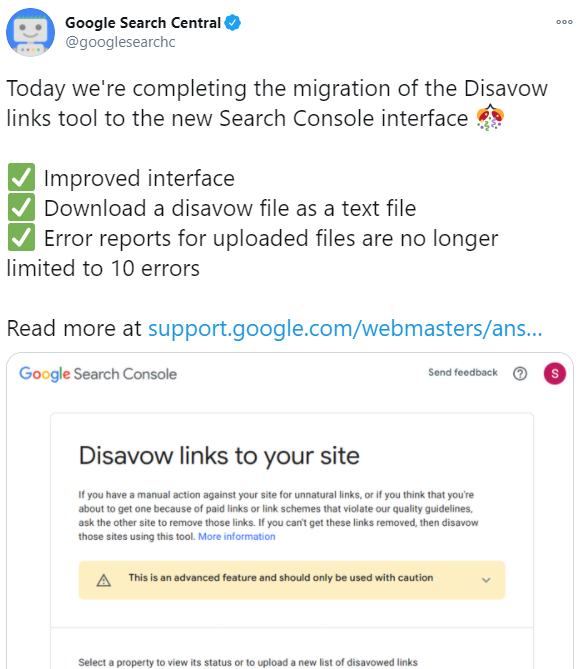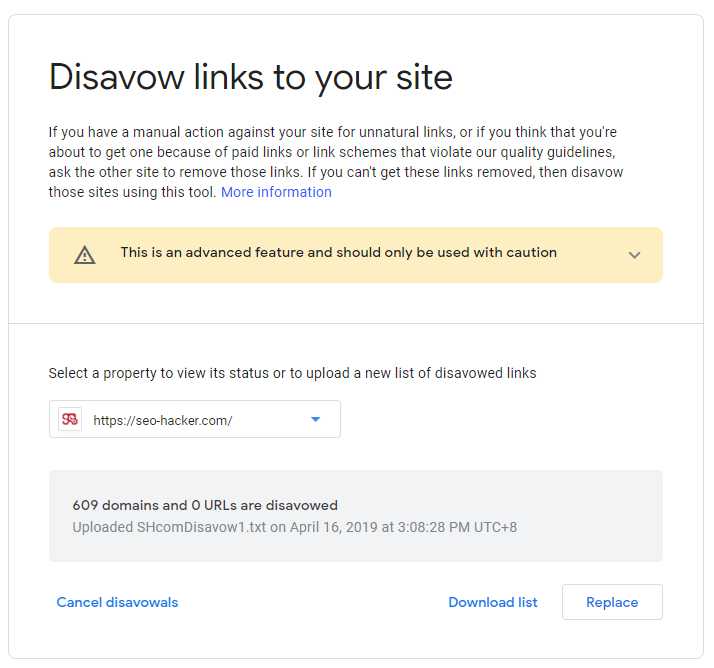The Complete Guide to the Disavow Tool
The Disavow Tool is a popular tool that is used by SEO experts and website owners to protect their website from receiving any penalties from Google or avoid any ranking drops due to unwanted toxic backlinks.
Recently, Google announced that the Disavow Tool is finally being migrated to Google Search Console after being left when Google Search Console legacy tools were migrated last year. They gave the disavow tool a fresh but still simple interface and a few improvements.

There are so many tools out there that you can use to play around but the disavow tool is an exception. It is a tool that should only be used when necessary and you should not use it if you don’t fully understand what it does. With that being said, here is the full guide to Google’s Disavow Tool.
What is Google’s Disavow Tool?
The Disavow Tool allows website owners to submit a list of backlinks that they would want Google to ignore. The disavow tool is free to use and is available for all websites verified in Google Search Console.
If your website has backlinks that violate Google’s Guidelines on Link Schemes, your website may receive a Manual Action from Google. You can use the disavow tool to clean up your backlink profile and avoid any penalties from Google.
Do I Really Need to Disavow All Unnatural Backlinks?
This tweet of John Mueller when the migration of the disavow tool was announced pretty much summed up the answer to this question.

Google’s algorithm is able to identify which of the backlinks of a website are unnatural and automatically ignores them. If your website has unwanted spammy backlinks, they have little to no chances of negatively affecting your rankings.
This means most of the time, you don’t have to use the disavow tool.
When Should You Use the Disavow Tool?
There will only be a handful of situations where the use of the disavow tool is necessary. In fact, most websites on the internet do not have to use the disavow tool at all.
Let’s say you’re handling a website that has a history of buying links and to your surprise when you opened its Google Search Console, there is a manual action notification from Google. As mentioned earlier, if your website receives a manual action from Google regarding unnatural links to your website, disavowing those links would help clear up the problem. Once you’ve submitted a disavow file, you could then ask for a review of the manual action.
Another situation would be if your website is subject to negative SEO attacks. Negative SEO is a black hat SEO strategy that is used to sabotage the rankings of a website. One of its main strategies is to build hundreds or thousands of spammy links to a website.
However, this is the exact reason why Google has improved its algorithm to automatically detect spammy links and ignore them. Websites that are affected by negative SEO is very rare. But if you experience rankings drops and believe it is caused by spammy links, then you could use the disavow tool to add an extra layer of support.
Some of our websites had experienced these kinds of attacks and our rankings were not affected at all. In our case, we didn’t even use the disavow tool at all.
Take Note of the Risks
The disavow tool is a delicate tool and should be used with care. If you accidentally disavowed backlinks that are actually beneficial to your website, you might end up negatively affecting your rankings instead.
If you’re using the disavow tool, make sure to have a keen eye and always double-check before you finalize things up.
How to Use the Disavow Tool
Step 1: Log in to Google Search Console and search for the Disavow Tool
The first step is really easy. Just make sure that you are logged in to your Google Search Console account then go to the Disavow tool page. There is no link to the Disavow tool from the main Google Search Console dashboard and you would need to do a quick search every time you want to go to the tool page so remember to bookmark the link. This is what you should be seeing.

Step 2: Prepare the list of links to be Disavowed and the Disavow File
To find unnatural/toxic backlinks that need to be disavowed, you could refer to the Links report of Google Search Console or you could use other tools such as Ahrefs, SEMRush, Cognitive, and Mangools.
Again, be mindful of the risks of using the disavow tool. If you disavow links that actually helps your website, then you could negatively affect your rankings by accident.
For the disavow file, all you need to do is open Notepad on your computer. There are two formats to follow; one for single URL disavow and second is for domain disavow.
If you want to disavow a single URL, simply copy and paste the full URL. Only one URL per line. The maximum URL length is 2,048 characters.
If you want to use domain disavow, start every line with “domain:” followed by the domain you want to disavow.
Sample:
disavow:website1.com
disavow:website2.com
disavow:website3.com
Take note that using domain disavow means all links from that domain will be ignored by Google.
Another thing to take note of is that the maximum file size of a disavow file is 100,000 lines and 2mb but I’m pretty sure you won’t need to disavow that many links.
Step 3: Submit your Disavow File
Once you’re done preparing your disavow file, simply save it as a .txt file and upload it in the disavow tool page.
Google will then show you the total number of domains and URLs that were disavowed and if there are any errors in your file.

After uploading your disavow file, you could download it again, replace it, or cancel it anytime.
Key Takeaway
I know I’ve said it multiple times but always remember to only use the disavow tool when necessary and do not play around with it. If your website is experiencing ranking drops but there is no manual actions from Google, there is a higher chance that the cause is different from unnatural backlinks. Only use the disavow tool if you have exhausted all of your options.
I rarely use the disavow tool myself. Here at SEO Hacker, we practice only white hat SEO strategies that is why we are not afraid of being affected by spammy links. Have you experienced ranking drops due to spammy links? Was the disavow tool able to help you? Let me know through the comment section below.
